

5 Essential Customer Satisfaction Survey Questions. Measuring customer satisfaction is incredibly important because satisfaction is a strong predictor of future behavior (e.g. the probability of buying again and/or the probability of your customers referring others).
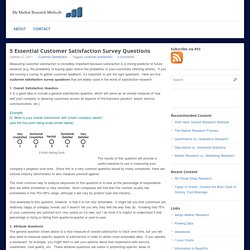
If you are running a survey to gather customer feedback, it’s important to ask the right questions. Here are five customer satisfaction survey questions that are widely used in the world of satisfaction research. 1. Overall Satisfaction QuestionIt is a good idea to include a general satisfaction question, which will serve as an overall measure of how well your company is pleasing customers across all aspects of the business (product, brand, service, communication, etc.).
ExampleQ: What is your overall satisfaction with (insert company name)? 5 Point Rating Scale The results of this question will provide a useful baseline to use in measuring your company’s progress over time. One downside to this question, however, is that it is not very actionable. ASQ Service Quality Division. 3 Minute Product Manager: Kano Model.
Business Model Generation (and CVP's) Kano Modeling in Product Development. Kano modeling describes the relationships between fulfillment of a consumer requirement and satisfaction/dissatisfaction experienced by an individual consumer.

This theory was proposed by Professor Noriaki Kano of Tokyo Rika University, Japan1. In sensory evaluation, an attribute that is fully implemented would be an optimal intensity. This is an important difference with attributes where for example more is better. Kano modeling states that the relationship between the performance of a product attribute and satisfaction/dissatisfaction level is not necessarily linear. Some attributes can be asymmetrically related with satisfaction/dissatisfaction levels. Figure 1. The classification of each attribute can be identified through Kano’s paired functional/ dysfunctional questionnaire and its evaluation table (Figure 2 and Table 1)1 ,2.
Figure 2. There are several advantages to classify consumer requirements into Kano modeling attributes3: The ‘moment of truth’ in customer service. In recent years, mature companies with far-flung networks of frontline sales staff—banks, retailers, airlines, and incumbent telecom providers, for example—have devoted a great deal of money and effort to retaining their current customers.
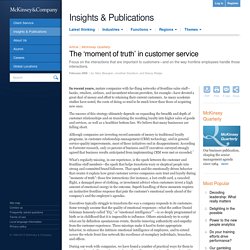
As many academic studies have noted, the costs of doing so tend to be much lower than those of acquiring new ones. The success of this strategy ultimately depends on expanding the breadth and depth of customer relationships and on translating the resulting loyalty into higher sales of goods and services, as well as a healthier bottom line. We believe that many businesses are falling short. Although companies are investing record amounts of money in traditional loyalty programs, in customer-relationship-management (CRM) technology, and in general service-quality improvements, most of these initiatives end in disappointment. Executives typically struggle to transform the way a company responds to its customers.
High emotion, high performance. Voice of the Customer Table (VOCT) Quality function deployment (QFD) begins with an exploration and discovery of customer needs.
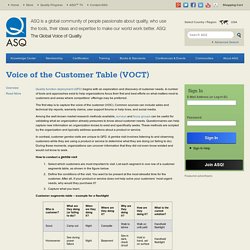
A number of tools and approaches exist to help organizations focus their first and best efforts on what matters most to customers and areas where competitors’ offerings may be preferred. The first step is to capture the voice of the customer (VOC). Common sources can include sales and technical trip reports, warranty claims, user support forums or help lines, and social media. Among the well-known market research methods available, surveys and focus groups can be useful for validating what an organization already presumes to know about customer needs. Questionnaires can help capture new information an organization knows to exist and specifically seeks. In contrast, customer gemba visits are unique to QFD. How to conduct a gemba visit Select which customers are most important to visit. Voice of Customer Programs. What is Voice of the Customer (VoC)?
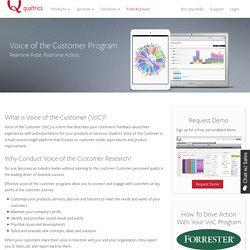
Voice of the Customer (VoC) is a term that describes your customer’s feedback about their experiences with and expectations for your products or services. Qualtrics Voice of the Customer is a multi-source insight platform that focuses on customer needs, expectations and product improvement. Why Conduct Voice of the Customer Research? No one becomes an industry leader without listening to the customer. Customer Satisfaction Survey Questions: 5 Sample Templates You Can Use Right Away - Qualtrics. Download the eBook: Customer Satisfaction Survey Templates Customer satisfaction is at the core of human experience, reflecting our liking of a company’s business activities.
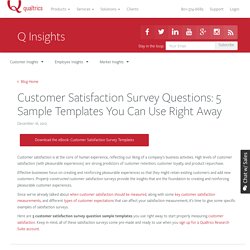
High levels of customer satisfaction (with pleasurable experiences) are strong predictors of customer retention, customer loyalty, and product repurchase. Effective businesses focus on creating and reinforcing pleasurable experiences so that they might retain existing customers and add new customers. Properly constructed customer satisfaction surveys provide the insights that are the foundation to creating and reinforcing pleasurable customer experiences. Since we’ve already talked about when customer satisfaction should be measured, along with some key customer satisfaction measurements, and different types of customer expectations that can affect your satisfaction measurement, it’s time to give some specific examples of satisfaction surveys. 1.
Sincerely, [MANAGER_NAME] Manager. The ‘moment of truth’ in customer service. MysteryShopper.com.au. Wiley: The Intelligent Company: Five Steps to Success with Evidence-Based Management - Bernard Marr, Thomas H. Davenport.